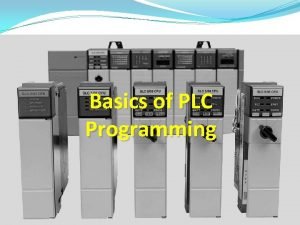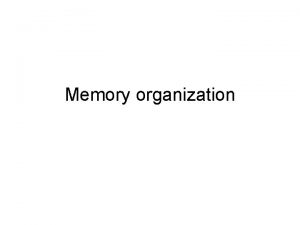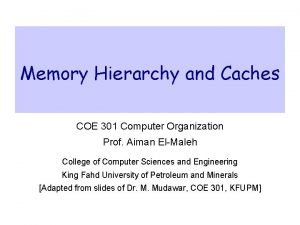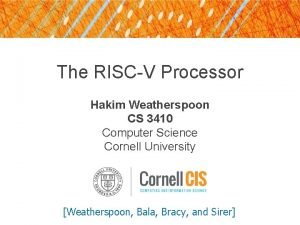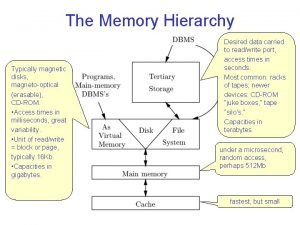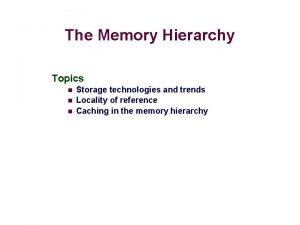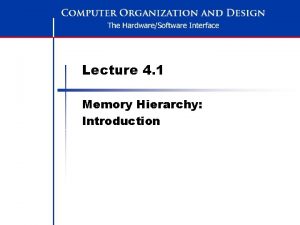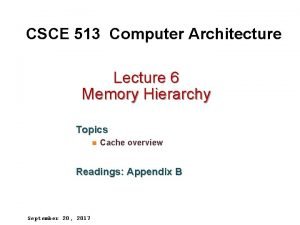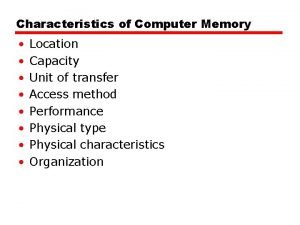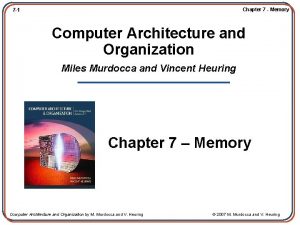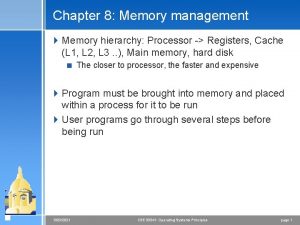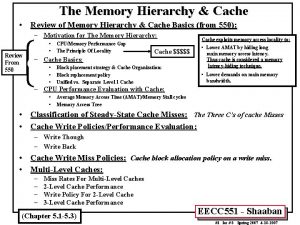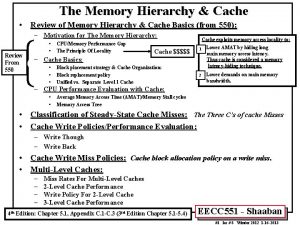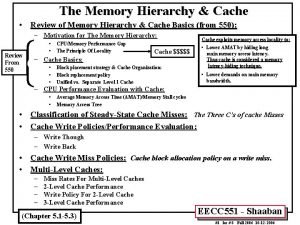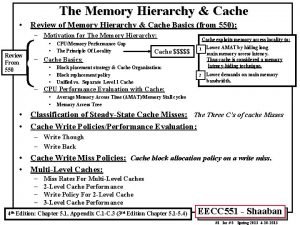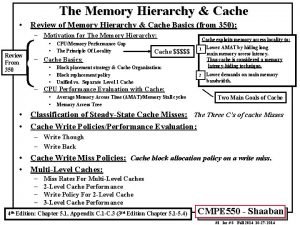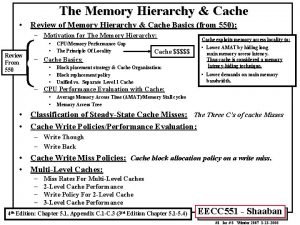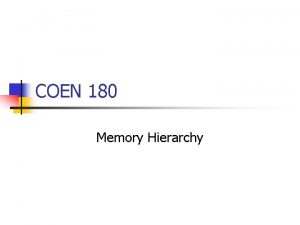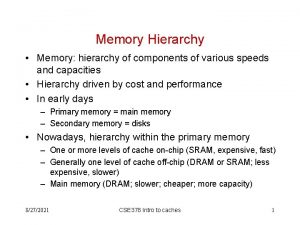Chapter 8 Memory management 4 Memory hierarchy Processor















- Slides: 15

Chapter 8: Memory management 4 Memory hierarchy: Processor -> Registers, Cache (L 1, L 2, L 3. . ), Main memory, hard disk < The closer to processor, the faster and expensive 4 Program must be brought into memory and placed within a process for it to be run 4 User programs go through several steps before being run 12/6/2020 CSE 30341: Operating Systems Principles page 1

Multistep Processing of a User Program 12/6/2020 CSE 30341: Operating Systems Principles page 2

Binding of Instructions and Data to Memory Address binding of instructions and data to memory addresses can happen at three different stages 4 Compile time: If memory location known a priori, absolute code can be generated; must recompile code if starting location changes 4 Load time: Must generate relocatable code if memory location is not known at compile time 4 Execution time: Binding delayed until run time if the process can be moved during its execution from one memory segment to another. Need hardware support for address maps (e. g. , base and limit registers). 12/6/2020 CSE 30341: Operating Systems Principles page 3

Loading programs 4 Dynamic loading < Routine is not loaded until it is called < Better memory-space utilization; unused routine is never loaded < Useful when large amounts of code are needed to handle infrequently occurring cases < No special support from the operating system is required implemented through program design 4 Dynamic Linking < Linking postponed until execution time < Small piece of code, stub, used to locate the appropriate memory -resident library routine < Stub replaces itself with the address of the routine, and executes the routine < Operating system needed to check if routine is in processes’ memory address < Dynamic linking is particularly useful for libraries 12/6/2020 CSE 30341: Operating Systems Principles page 4

Logical vs. Physical Address Space 4 The concept of a logical address space that is bound to a separate physical address space is central to proper memory management < Logical address – generated by the CPU; also referred to as virtual address < Physical address – address seen by the memory unit 4 Logical and physical addresses are the same in compile-time and load-time address-binding schemes; logical (virtual) and physical addresses differ in execution-time address-binding scheme 12/6/2020 CSE 30341: Operating Systems Principles page 5

Memory-Management Unit (MMU) 4 Hardware device that maps virtual to physical address 4 In MMU scheme, the value in the relocation register is added to every address generated by a user process at the time it is sent to memory 4 The user program deals with logical addresses; it never sees the real physical addresses 12/6/2020 CSE 30341: Operating Systems Principles page 6

Dynamic relocation using a relocation register MMU is a hardware component OS manages the relocation register 12/6/2020 CSE 30341: Operating Systems Principles page 7

Swapping 4 A process can be swapped temporarily out of memory to a backing store, and then brought back into memory for continued execution 4 Backing store – fast disk large enough to accommodate copies of all memory images for all users; must provide direct access to these memory images 4 Roll out, roll in – swapping variant used for prioritybased scheduling algorithms; lower-priority process is swapped out so higher-priority process can be loaded and executed 4 Major part of swap time is transfer time; total transfer time is directly proportional to the amount of memory swapped 4 Modified versions of swapping are found on many systems (i. e. , UNIX, Linux, and Windows) 12/6/2020 CSE 30341: Operating Systems Principles page 8

Schematic View of Swapping 12/6/2020 CSE 30341: Operating Systems Principles page 9

Contiguous Allocation 4 Main memory usually into two partitions: < Resident operating system, usually held in low memory with interrupt vector < User processes then held in high memory 4 Single-partition allocation < Relocation-register scheme used to protect user processes from each other, and from changing operating-system code and data < Relocation register contains value of smallest physical address; limit register contains range of logical addresses – each logical address must be less than the limit register 12/6/2020 CSE 30341: Operating Systems Principles page 10

A base and a limit register define a logical address space 12/6/2020 CSE 30341: Operating Systems Principles page 11

HW address protection with base and limit registers 12/6/2020 CSE 30341: Operating Systems Principles page 12

Contiguous Allocation (Cont. ) 4 Multiple-partition allocation < Hole – block of available memory; holes of various size are scattered throughout memory < When a process arrives, it is allocated memory from a hole large enough to accommodate it < Operating system maintains information about: a) allocated partitions b) free partitions (hole) OS OS process 5 process 9 process 8 process 2 12/6/2020 process 10 process 2 CSE 30341: Operating Systems Principles process 2 page 13

Dynamic Storage-Allocation Problem How to satisfy a request of size n from a list of free holes 4 First-fit: Allocate the first hole that is big enough 4 Best-fit: Allocate the smallest hole that is big enough; must search entire list, unless ordered by size. Produces the smallest leftover hole. 4 Worst-fit: Allocate the largest hole; must also search entire list. Produces the largest leftover hole. First-fit and best-fit better than worst-fit in terms of speed and storage utilization 12/6/2020 CSE 30341: Operating Systems Principles page 14

Fragmentation 4 External Fragmentation – total memory space exists to satisfy a request, but it is not contiguous 4 Internal Fragmentation – allocated memory may be slightly larger than requested memory; this size difference is memory internal to a partition, but not being used 4 Reduce external fragmentation by compaction < Shuffle memory contents to place all free memory together in one large block < Compaction is possible only if relocation is dynamic, and is done at execution time < I/O problem - I/O may be performed by a DMA controller = Latch job in memory while it is involved in I/O = Do I/O only into OS buffers 12/6/2020 CSE 30341: Operating Systems Principles page 15
 Virtual memory in memory hierarchy consists of
Virtual memory in memory hierarchy consists of The memory organization of a plc is often called
The memory organization of a plc is often called Give the structure of commercial 8mx 8 bit dram chip
Give the structure of commercial 8mx 8 bit dram chip Processor memory gap
Processor memory gap How 0x86 processor stores ox12345678 in memory?
How 0x86 processor stores ox12345678 in memory? Magnetic disk in memory hierarchy
Magnetic disk in memory hierarchy ड्रा मेमोरी हायरार्की
ड्रा मेमोरी हायरार्की Memory hierarchy diagram
Memory hierarchy diagram Memory hierarchy in os
Memory hierarchy in os Explain memory hierarchy
Explain memory hierarchy Memory hierarchy in computer architecture
Memory hierarchy in computer architecture Memory hierarchy
Memory hierarchy Computer memory hierarchy diagram
Computer memory hierarchy diagram Memory hierarchy definition
Memory hierarchy definition Characteristics of computer memory
Characteristics of computer memory Memory hierarchy in coa
Memory hierarchy in coa

